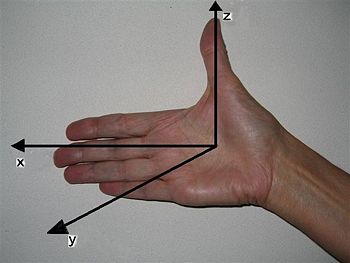Right-hand rule: Difference between revisions
Jump to navigation
Jump to search

imported>Paul Wormer No edit summary |
imported>Caesar Schinas m (Bot: Update image code) |
||
| Line 1: | Line 1: | ||
{{subpages}} | {{subpages}} | ||
{{Image|Right-hand-rule.jpg|right|350px|Right-hand rule. Move open palm of right hand from ''x'' to ''y'', then thumb is direction of ''z''.}} | |||
The '''right-hand rule''' is a rule that appears in the [[cross product]], | The '''right-hand rule''' is a rule that appears in the [[cross product]], | ||
:<math> | :<math> | ||
Revision as of 11:51, 11 June 2009
The right-hand rule is a rule that appears in the cross product,
The direction of the unit vector ez given as the cross product of unit vectors along the x- and y-axis is given by the right-hand rule, see photograph.
The case depicted here has a right (90° degree) angle α between the x- and the y-axis. However, the rule works for any angle α between x- and y-axis, as long as 0° < α ≤ 180°. The z-axis is always perpendicular to the plane containing the x- and y-axes.

